- This article, by students of Chettinad Hari Shree Vidyalayam, a leading Chennai school, focusses on inscriptions during the Pallava era.
This essay contains abstract, introduction, how they came to power,
capital town, Mahabalipuram, extent of dynasty, Inscriptions, Major inferences
from their inscriptions and Conclusion. This paper focuses on Pallava
inscriptions, which provide a detailed insight about the Pallavas’ ancestors,
wars fought, victory records, religious beliefs and contributions of the kings
of the Pallava dynasty.
Abstract
Cholas/Cōḻarkaḷ,
Cheras/Cērar, Pandyas/Pāṇṭiyarkaḷ, Pallavas/Pallavarkaḷ were the predominantly
known South Indian kingdoms and have left an irreplaceable mark in
history. The major focus of this
research is Pallavas/Pallavarkaḷ and their contributions traced out through
their inscriptions.
The major
sources for history or how we get to know about ancient dynasties is through
the architectural work, inscriptions, coins and other excavations that have
been found out. These sources are very important as they help us trace out the
social practices, economy and lifestyle that was followed.
Inscriptions are
basically writings, scriptures and drawings on monoliths, stones and relatively
on hard materials and act as an important source for history as they tell us
about aspects varying from messages, ownership of property, victories over
other kingdoms, hymns, shlokas, story of the monument, praises of the king(s)
and much more.
The Pallava inscriptions are found to be in Prakrit (earliest), Sanskrit and Tamil but more of Tamil as predominantly their settlement was near Kanchipuram/Kāñcipuram and Mahabalipuram/Makāpalipuram region in Tamil Nadu but they did have their empires extending to belts of Tanjore and Trichy.
The major focus
of this paper would be the Pallava inscriptions that have been discovered. They
have actually helped to trace the chronological order of the Pallava dynasty
and also the foreign influences in the construction of the structure.
Introduction
In the latter
half of the 6th century, a new dynasty called the Pallavas came to power in
South India. The moment we state important South Indian kingdoms, names of
great dynasties like the Cholas, Cheras, Pandyas and later the Vijayanagara Empire
and Chalukyas are discussed.
When it comes to power tussle and power politics, South Indian history has always been a great example for this as three to four kingdoms have always waged war with each other to establish their power and rule the zone.
There are many
theories about the origin of the Pallavas. Many historians and researchers have
mentioned that the name Pallava was a disambiguation of Pahlava who were of
Scythian origin. Many others have sought to connect them with Jaffna,
identified with the island of Manipallavam mentioned in the Manimekalai/Maṇimēkalai.
(http://www.preservearticles.com/short-essays/short-essay-on-the-Pallavas/Pallavarkaḷ -dynasty/13636 (accessed on 12th December 2019)
Also, another view
is that Pallava is a Sanskrit word meaning tender shoots and leaves of a plant.
The northern parts of Tamil Nadu and southern parts of Andhra Pradesh were
under the rule and control of the Pallavas. Their capital was Kanchi.
By the beginning
of the seventh century AD, there were three major states which were seen
emerging in southern India and these were: the Pallavas along with the
Chalukyas of Badami and the Pāṇṭiyarkaḷ of Madurai.
Their kingdom,
referred to as Tondaimandalam, stretched from southern Andhra Pradesh to
northern Tamil Nadu - the fertile plains between the river basins of the Penna
and Ponnaiyar rivers. Kanchipuram/Kāñcipuram was the capital of their empire and the port city of Mahabalipuram, the source of all their wealth.
How they came to powerThe founder of the
Pallava dynasty was Simha Vishnu who was said to be a very efficient and strong
ruler. After the death of Simha Vishnu, Mahendravarman, his son succeeded him, and
he was also believed to be a very efficient ruler and extremely learned.
The famous cave
temple at Mahabalipuram was constructed based on his ideas. The news about the
upcoming and prosperous dynasty spread all around and the famous Chalukya
Pulakesi-II came to know about the richness and abundance of the kingdom. He
attacked the kingdom and successfully defeated Mahendravarman.
The Pallavas were defeated only because their leader Mahendravarman died during the battle. His son, Narasimhavarman ascended the throne after him. It is said that Narasimhavarman vowed to take revenge for his father's death. He is believed to be physically well-built and having great intelligence. With planning, plotting and tactics, he almost destroyed the Chalukya Pulakesi kingdom.
He got a number of
temples constructed in the capital Kanchi. It was in 740 AD, that the Pallava
supremacy completely ended in South India when the Chalukyas overran the
Pallavas in the revived conflict. (https://www.mapsofindia.com/history/pallava-dynasty.html
(accessed on 12th December 2019)
Capital Town
The town of Kanchipuram
was the capital of the Pallavas. Kanchi is best known for history, culture, art
and architecture.
In
Sanskrit there is a saying which glorifies this place, ‘Nagareshu Kanchi/Nākarēṣu kāñci’, meaning the first
among cities. The earliest reference to the city is in the
Mahabhashya of Pathanchali of the 2nd century BCE. Later Tamil works of
the 2nd century CE
like Manimekala and Perumbhanatrupadai talk about the town
as it was during that time.
Chinese Buddhist
scholar Hieun Tsang travelled here in the 6th century CE and recorded his
account about the town, while Marco Polo noted his views during his visit in
the 12th century CE.
Bodhidharma/Pōtitarmar,
said to be the son of a Pallava king and founder of Chan Buddhism travelled to
Canton in China around 520 CE. The Saivite poet Appar of the 7th century CE and
a contemporary of Mahendravarman described the city as a storehouse of
immeasurable knowledge and learning.
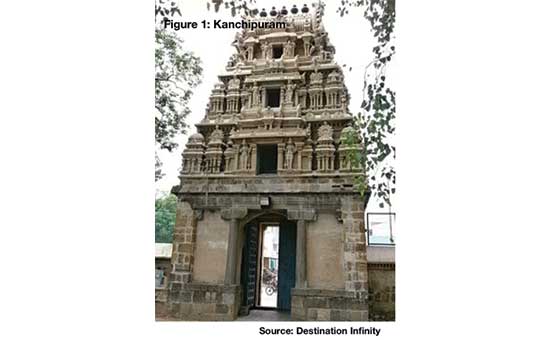 Kanchipuram
Kanchipuram
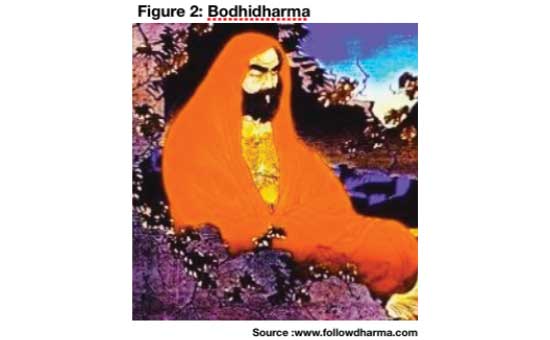 Bodhidharma
Bodhidharma
Mahabalipuram
Mahabalipuram/Makāpalipuram was once a thriving city port. Lying on the Coromandel Coast, Mahabalipuram/Makāpalipuram was renamed Mamallapuram during the reign of the Pallava King Narasimhavarman/Naracim’mavarmaṉ I. The title "Mamalla" meaning "the great wrestler" was given to the king considering his bravery and achievements.
Mahabalipuram was an ancient port of the Pallavas, who
have created many marvelous monuments with sculptural panels, caves, monolithic
rathas and temples. It
is referred as an ‘open-air museum’. The architecture and
sculptures reflect the stylistic qualities of the great Pallava kings, Narasimha I and Rajasimha (https://www.nativeplanet.com/travel-guide/mahabalipuram-where-the-pallavas-once-reigned/articlecontent-pf925-000313.html
(accessed on 21st December 2019)
The port was constructed by Emperor Mahendra Varman in the
7th century. Famous monuments in Mahabalipuram include:
1. Shore Temple
2. Arjuna’s Penance
3. Varaha Temple
4. Mahishasuramardini
5. Krishna’s Butterball
6. Pandava Rathas
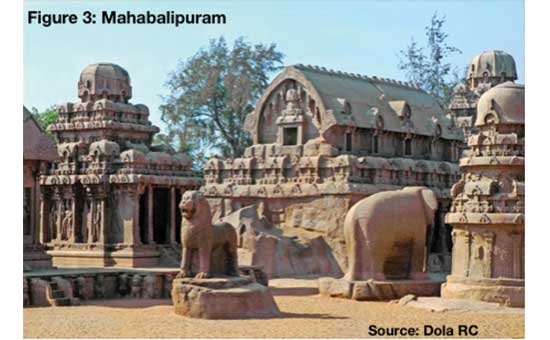 5 Rathas Mahabalipuram
5 Rathas Mahabalipuram
Extent of the Empire
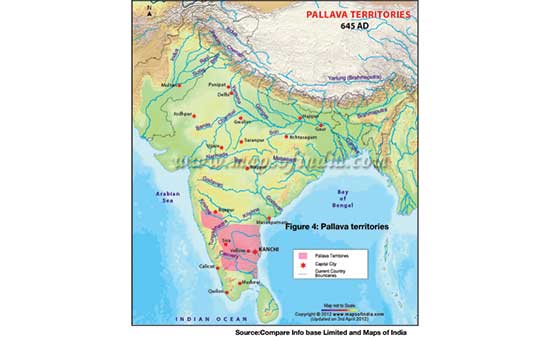 Extent of the Empire
Extent of the Empire
Inscriptions
Major Inscriptions of the Pallavas
Inscriptions are
the major source of information in history. Inscriptions are writings or texts
carved on solid objects such as pillars, walls, temples, forts, caves, palaces
and stone. It is known as epigraphic information as they provide authentic
information about various dynasties and their contributions.
Pallava Inscriptions:
1. Pillars
2. Temple walls
3. Written books
Languages used
and where they were found:
Languages
used were mainly Prakrit, Sanskrit, Tamil and Telugu.
All early Pallava
inscriptions were either in Sanskrit or Prakrit as these were considered the
official languages of the dynasty. Some official scripts of Pallavas/Pallavarkaḷ
were in Grantham/Kirantam.
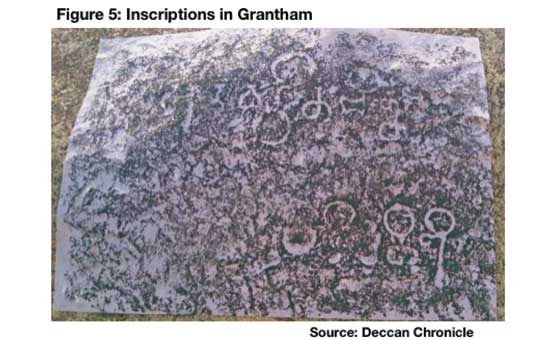 Inscription in Grantham
Inscription in Grantham
Inscriptions
found in Andhra Pradesh and Karnataka state were in Sanskrit and Prakrit.
(https://www.jstor.org/stable/25189883?seq=1
(accessed on 13th December 2019)
Pallava
inscriptions in Prakrit were also found in Palnad taluk of Guntur district,
which speaks about King Simhavarman. This inscription is also an evidence to
show that they adopted Tamil later.
Subsequently,
Tamil became the
main language to be used by the Pallavas/Pallavarkaḷ in their inscriptions.
This language was first adopted by Mahendravarman I himself in a few records of
his and from the time of Paramesvaravarman I, the records were inscribed mostly
in Sanskrit and the rest in Tamil. (http://ignca.gov.in/Asi_data/21935.pdf (accessed on 13th December 2019)
Tamil works of the 2nd century CE like Manimekalai and Perumbhanatrupadai talk about the town, Kanchipuram/Kāñcipuram as it was during that time. (https://www.ancient.eu/article/1336/on-the-pallava-trail-in-Kanchipuram/Kāñcipuram / (accessed on 13th December 2019)
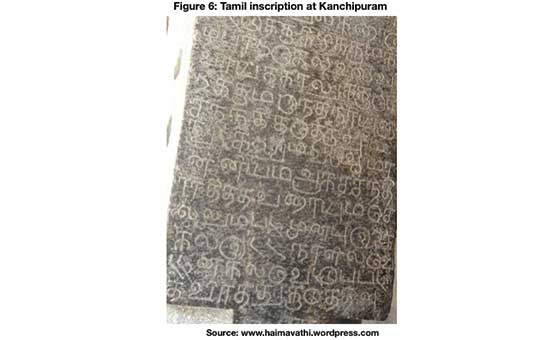 Tamil inscription at Kanchipuram
Tamil inscription at Kanchipuram
Major inferences from their inscriptions
1. Ancestors:
The history of
the Pallavas/Pallavarkaḷ are recorded in Sanskrit and can be seen
at Amaravati in
Andhra. From the inscriptions, the ancestral lineage of Pallavas/Pallavarkaḷ remain
mystical. It talks about a child of a union between the apsara Madani and the
brahman warrior Ashwathaman, descendent of sage Bharadvaja, the son of Brahma. (South Indian
History Congress, The Congress, 1980, 2008)
There is only a single record of Mahedravarman III/Makēntiravarmaṉ, which is found on a slab set up in a street at Kanchipuram/Kāñcipuram. The whole previous Pallava history concluding with the coronation of Prince Nandivarman
is depicted in
sculptures elaborately carved on the walls of the verandah around the
Garbhagriha of the Vaikunthaperumal temple at Kanchipuram/Kāñcipuram.
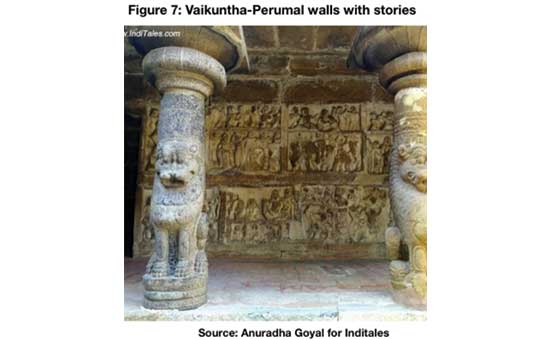 Vaikuntha Piramal wall with stories. Courtesy Anuradha Goyal of Indiatales
Vaikuntha Piramal wall with stories. Courtesy Anuradha Goyal of Indiatales
2. Wars fought:
Narasimhavarman/Naracim'mavarmaṉ I met the Chalukyas and defeated them in three separate encounters in Pariyala, Suramana and Manimangala, all close to the Pallava capital Kanchi, forcing them to retreat.
In 642 CE, a
Pallava force under Paranjothi was sent by Narasimhavarman to capture Vatapi,
the capital of the Chalukyas. Pulakesi-II met the Pallavas on the outskirts of
his capital and is said to have lost his life in the ensuing battle.
The Pallavas achieved a decisive victory over Pulakeshin II and took the capital. Narasimhavarman I constructed a Mallikarjuna Temple at Vatapi to commemorate his victory. He also adopted the title “Vatapi-kondan” or “taker of Vatapi.
He carved an
inscription recording his victory on the walls of the Teggina-Irappa temple in
Vatapi. Paranjothi brought numerous items of war booty to the Pallava kingdom
from Vatapi, including a famous icon of Lord Ganesha (Ganapathi) known as
Vatapi Ganapathi, which he enshrined in his hometown. (https://www.studyiq.com/blog/battle-of-pullalur-manimangala-and-Vatapi/Vātāpi/ (accessed on 13th December 2019)
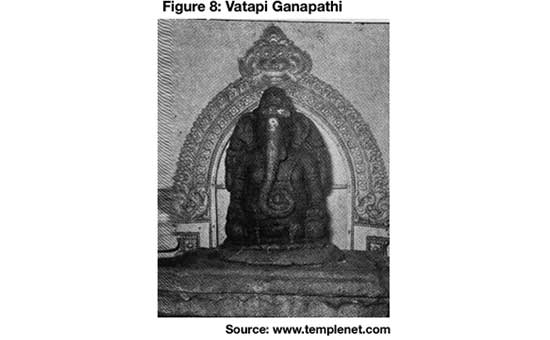 Vatapati Ganapati.
Vatapati Ganapati.
3. Victory records:
The Pallava
victory of Narasimhavarma is found on an inscription at the Mallikarjuna
temple at Vatapi/Vātāpi, which corresponds to 642-43 AD. It was probably
engraved after the capture and victory over Chalukyas. (http://timesofindia.indiatimes.com/articleshow/70939847.cms?utm_source=contentofinterest&utm_medium=text&utm_campaign=cppst
(accessed on 13th December 2019)
4. Religious beliefs:
In the Udayendiram plate of Nandivarman II, Simhavishnu is said to have been a devout worshipper of Vishnu, and this is noteworthy especially since his son Mahendravarman I, who followed Jainism earlier, later converted to Shaivism through the influence of Saint Appar. (https://www.whatisindia.com/inscriptions/south_indian_inscriptions/volume_12/introduction.html
(accessed on 13th December 2019)
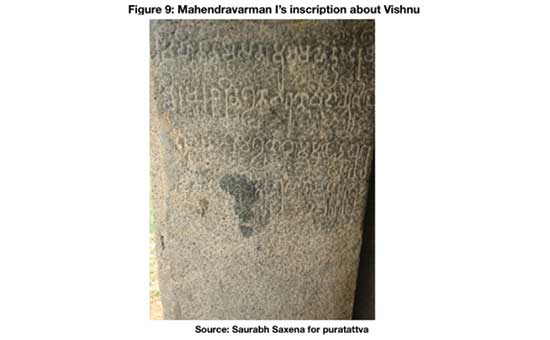 Mahendravarman’s inscription on Vishnu. Credit Saurabh Shukla for Puratattva
Mahendravarman’s inscription on Vishnu. Credit Saurabh Shukla for Puratattva
5. Kings and their contributions:
Numerous inscriptions around the Kailasanadha temple are in 3 different scripts: Nagari, Pallava-Grantha and calligraphic Nagari. 320
titles in praise of the King Rajasimha are found among them which speak of the
munificence of the king, his valour and charity done by him.
One of the
inscriptions, written in the Kannada script speaks about Vikramaditya Chalukya,
who had invaded Kanchi with rage and he encountered this temple. Vikramaditya
Chalukya, astounded by its architectural beauty, ordered his commanders not to
touch anything in this conquered town and instead presented gold and jewellery
as offerings to the God. His queen Loka Mahadevi too, having been impressed
with this, is said to have taken artisans from Kanchi to build a similar temple
at her home location of Pattadakal, and that today stands as the Virupaksha
Temple. (https://brewminate.com/on-the-pallava-trail-in-kanchipuram (accessed
on 22nd December 2019)
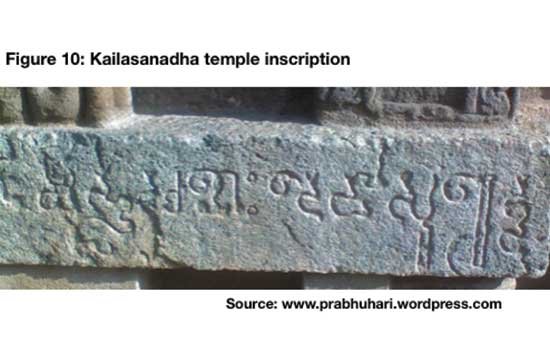 Kailasanadha temple inscription.
Kailasanadha temple inscription.
Conclusion
The Pallavas
were a prominent and dominating South Indian kingdom, which has heavily
influenced culture in South India with some unparalleled contributions.
The Pallava
inscriptions provide to us credible information about various dynasties and
their valuable contributions, which help us analyze in great depth about the
contemporary social, cultural, economic and political set-up during the Pallava
period in South India. These inscriptions provide a detailed insight about the
Pallavas’ ancestors, wars fought, victory records, religious beliefs and
contributions of the kings. Therefore, without a doubt we can say that the
Pallavas have gone down in history as one of the mightiest kingdoms of South
India.
To read all
articles by students
Grade 9 Group: Vidur Ashwin, Arjuun B, Dhruv T, Vaghul Kumar, Vishal Sachin Perla, Nikhil
Loganathan, Shabbir H Madraswala, Vishakan Ponnusamy.
Readers are requested to
kindly consider the following:
1. These papers are submitted by students of Grade 9 (age group: 14-15
years). Their efforts may not be comparable with professional research work and
rigour.
2. This is the first time that these students have attempted studies on
these topics with comparatively limited access to reference materials and
resources, as compared to professional and advanced research initiatives.
3. Two key limitations faced by the students include:
i) Working primarily within the school premises, with no opportunity for
field-research or interviews with domain experts
ii) Time limitations, given academic commitments.
4. Citations and sources of references have been included in the
reports. However, in case any source or citation has been missed out, the same
is purely inadvertent, accidental or due to ignorance.
The above paper submitted by the students is part of an initiative called ‘Utsav’ conducted by the school aimed at developing awareness, interest and orientation for Indic wisdom, knowledge, history and philosophy, among students.